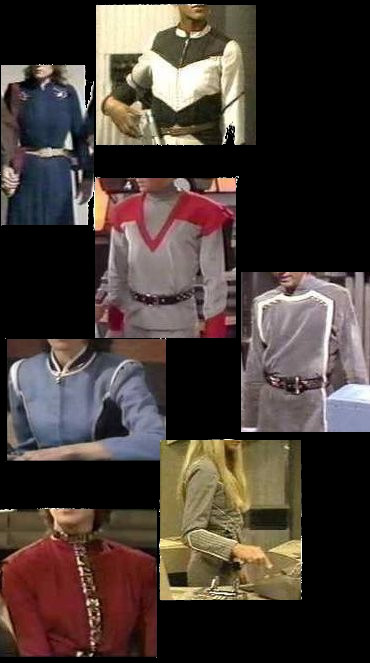Auxiliary Fleet Service
The civilian shipping that composes the bulk of the Fugitive Fleet are a diverse lot. There are private yachts, small, tramp freighters, giant industrial ships, corporate owned Agro ships, low budget passenger liners, mid range cruise liners, super luxury resort ships, SkyBuses, mining ships, tankers, Transporters, and almost every other kind of ship imaginable. Coordinating such a mish-mash of vessels into a tight, cohesive formation, allocating resources of food, fuel, space and parts in a fair a judicious manner was a monumental task that faced the officers of the Colonial Fleet.
In particular, the Regulars who were struggling to organise the Fleet in a defensible formation and impose some order and control, found that perpetual negotiations with the ship captains, especially the owner/operators, was a serious impediment to general safety and security. It was almost impossible to convince these captains that their yahrens of spacefaring was not a substitute for discipline, order and flight plans.
Additionally, there were several incidents of civilian ships ‘joining’ the Fleet, taking the opportunity to stock up on supplies and fuel, then leaving at the earliest opportunity
Declaring Martial Law provided a short term solution, but something needed to be done organizationally for the long term. At Commander Adama’s request, the Council of Twelve passed a series of Edicts addressing the problems.
First, all the ships in the Fleet that were benefiting from the supplies and protection of the Fleet, were taken under ownership and control of the Council of Twelve. This was done through Lease/Purchase agreements with the owners when possible. With the corporate owned vessels, where the vast bulk of the shareholders were dead or dying in the Colonies, the Council ‘probated’ their interest into a Guardianship overseen by the Council of Twelve.
Second, all of the officers and crew of the civilian vessels were inducted, en masse, into the Auxiliary Fleet Services and made an adjunct of the Military. This brought all the crews under a unified command and made it possible to address individual problems through demotions and, or, transfers.
The civilian merchant fleets of the Colonies were generally organized differently then the Colonial Military. The highest ranking officer on a civilian vessel is the Captain, the balance of the officers are Lieutenants, sub-Lieutenants or Ensigns. Within the ship there are designations of ‘First,’ ‘Second’ and ‘Third’ officer to delineate the chain of command. This is true whether it is a small tramp freighter or a super luxury resort ship. (On a military ship, the bigger and more important the vessel the more senior the commanding officer with an array of other ranks descending from the Commander.)
Similarly there are tasks and functions on civilian ships that either do not exist on military ones, or have different tasks and job descriptions attached.
Chief Steward, is generally a Lieutenant or sub-lieutenant and outside the chain of command. The Chief Steward’s responsibility is the care and well being of the passengers on the ship. Depending on the number of passengers the Chief Steward will be aided by one or more Assistant Chief Stewards, usually Ensigns, and a host of Stewards which will range in rating from Petty Officers to Ordinary Crewman.
Purser, is generally a Lieutenant, who is not in the chain of command. His or her duty is to keep the ship’s books, see that cargo is paid for, passengers are paying and the crew is paid. The Purser also arranges docking fees, fueling costs, purchase of supplies and such. The purser will have one or more assistants, depending on the size of the ship. These assistants will be a sub-lieutenant and Ensigns.
Cargo Master, this officer, usually a lieutenant or sub-lieutenant outside the regular chain of command, is responsible for the loading, unloading and placing of all cargo and materials. He works closely with the Purser to ensure cargo and freight is in position for swift unloading for customers, and that everything that goes on or off the ship has been paid for. He also coordinates luggage and similar cargo for the passengers, working with the Stewards in this matter. He usually has one or more Ensigns as assistants.
On the cruise liners, where the emphasis is on passengers, there will be a Cruise Director who works with the Chief Steward, to keep the passengers entertained and amused. Usually a Lieutenant, with several assistants (depending on the number of passengers) who is not in the chain of command.
Auxiliaries, ship’s Crew and Officers Ranks and Warrior equivalent
Captain = Captain
Lieutenant = Senior Lieutenant
Sub-Lieutenant = Lieutenant
Ensign = Ensign
Chief Petty Officer = Chief Master Sergeant
Petty Officer = Master Sergeant
Senior Mate = Flight Sergeant
Mate = Sergeant
Leading Crewman = Flight Corporal
Able Crewman = Corporal
Ordinary Crewman = Private
Crewman Recruit = Recruit
Rather then attempting to reassign ranks and ratings, the Auxiliary Fleet Service adopted the civilian rating system and took all officers and crew at their current rating.
On most civilian ships of size, especially those that carry passengers regularly, or are part of a corporate structure, the crew have uniforms to distinguish them from passengers. On some of the smaller ships uniforms are luxuries. The Council Edict ordered that all Auxiliary crews wear uniforms, but rather then try and outfit the thousands of personnel with new attire, it authorized the use of current uniforms, though it standardized rank and duty insignia. At the request of Commander Adama, the uniform requirements stipulated that Auxiliary uniforms be markedly different, and easily distinguishable, from Military uniforms.
A sampling of Auxiliary Fleet Service Uniforms found throughout the Fugitive Fleet
